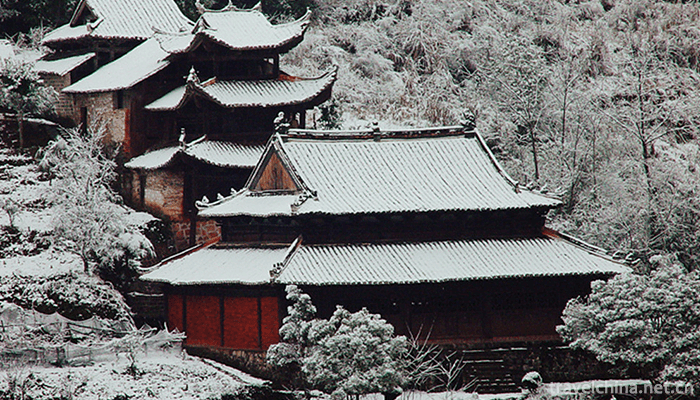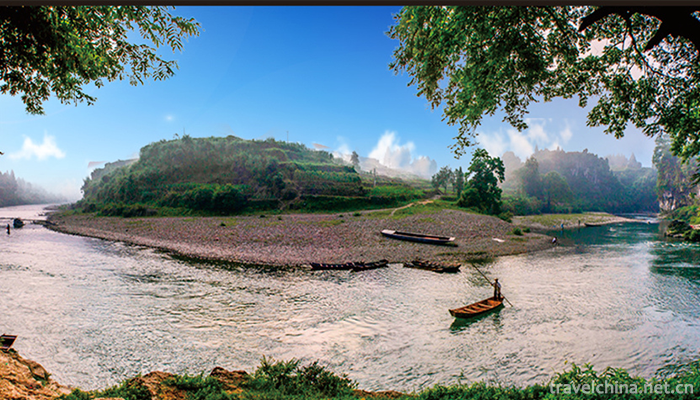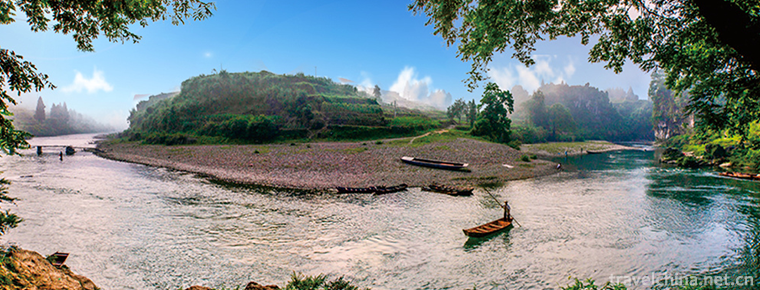Laosicheng Site
Laosicheng Site
Laosicheng Site is located in Laosicheng Village, Lingxi Town, more than 20 kilometers east of Yongshun County, Tujia and Miao Autonomous Prefecture, western Hunan Province. Fushicheng, originally named as Fushicheng, moved to Zhisha Township in 1724. In order to distinguish the old from the new, Fushicheng, also known as Laosheng, was the political, economic, military and cultural center of Peng Chieftain in Yongshun from Shaoxing in the Southern Song Dynasty (1135) to Yongzheng in the Qing Dynasty (1724).
Laoshi City is divided into Nero City and Wailuo City, with eight streets and ten lanes crisscrossing, densely populated and prosperous shops. Historical books include "3000 households in the city, 800 households outside the city", "the huge town of five streams, the border city of ten thousand miles".
Laosicheng is the materialized carrier of the Chieftain System and a living specimen of the development of the regional ethnic autonomy system in ancient China. It was announced as the fifth batch of national key cultural relics protection units in 2001. In September 2010, Laosicheng Site was listed in the list of the first national archaeological sites parks in China. On July 04, 2015, the "Chinese Chieftain Heritage" jointly represented by Laoshi City Site in Yongshun, Tangya Tusi City Site in Enshi, Hubei Province and Hailongtun Tusi Site in Zunyi, Guizhou Province was listed on the World Cultural Heritage List. On May 01, 2016, Laosicheng Site was officially opened as a scenic spot. In December 2016, Laosicheng scenic spot was listed as national AAAA-level tourist attraction.
Historical evolution
In the fourth year of Liang Kaiping (910 A.D.) after the Five Dynasties, Ma Yin, king of Southern Chu, admitted Peng Lung to Southern Chu and made Peng Lung serve as the assassin of Xizhou. Peng's kindness in Xizhou united the hearts of the people. He was welcomed by the people of Xizhou and became the hereditary chieftain of Xizhou.
In the fifth year of Shaoxing in the Southern Song Dynasty (1135), Peng Fushichong (Peng Fushichong) served as Chieftain. He often felt that Shizhi (Chieftain's Office) was bound by Chenzhou forces in Xiaxhou (Huixiping, Ancient Zhang County), so he moved Shizhi to Fushi County, Lingxi, and built a city here, that is, the Old Chicheng. There is another record about the change of Sizhi: before moving to Laoshi City, that is, in 971 A.D., the fourth Tusi Peng Yunlin moved Sizhi to Longtan City (Macha Township in Yongshun County today).
In the Yuan Dynasty, the original Xizhou was divided into Yongshun Anfu, Geman Anfu (under the jurisdiction of South Weizhou), and Sizhou Anfu (under the jurisdiction of Maizhe, Huixi, Shi Rong, Jidong and La Yao Dong). Peng Chieftain of Yongshun actually has limited space.
In the Ming Dynasty, Yongshun Tusi rebuilt Laosheng. Most of the existing buildings at the site were built in the Ming Dynasty.
In the second year of Yongzheng (1724), Peng Zhaohuai, the Tusi of Yongshun, moved Shizhi to Kesha Township in the upper reaches of Lingxi River, which is called Xinsi City. In 1728, Peng Zhaohuai, the Tusi of Yongshun, voluntarily offered his soil, took his descendants away from Hunan and Xiangxi, and returned to Jiangxi to establish a family. The regime of the Tusi of Yongshun, which lasted for 818 years, came to an end. Since then, Laoshi City has gradually become cold and depressed.
From 1995 to 2012, Hunan Institute of Cultural Relics and Archaeology, together with the Cultural Relics Task Force of Xiangxi Autonomous Prefecture and the Cultural Relics Bureau of Yongshun County, conducted five times of archaeological investigation, exploration and excavation of Laosicheng and its surrounding sites.
In 2010, Yongshun County Government launched the project of "Laoshi City Conservation and Utilization Project", which is expected to be completed in 2015. It plans to build the Laoshi City site into a national archaeological site park and a cultural and ecological tourism destination.
On September 29, 2015, Laosicheng National Archaeological Site Park officially opened.
On May 01, 2016, Laosicheng Site was officially opened as a scenic spot.
Protection of cultural relics
In October 1983, the ancestral temple and the ancient tomb group of Tusi in Laosicheng were listed as the fifth batch of key cultural relics protection units in Hunan Province.
In June 2001, the site of Laosicheng was announced by the State Council as a national key cultural relic protection unit.
In October 2010, Laosicheng Site was listed on the list of the first national archaeological sites parks in China.
In January 2011, Laosicheng Site was selected by the Chinese Academy of Social Sciences as the "Six New Archaeological Discoveries of China in 2010".
In October 2010, the director of the State Administration of Cultural Relics, Shan Jixiang, visited Laosicheng. Mr. Zhang Zhongpei, former president of the Palace Museum and President of the Chinese Archaeological Society, visited Laosicheng four times.
On November 18, 2012, Laosicheng Site entered the Preparatory List of World Cultural Heritage declared by the State Administration of Cultural Relics.
On April 13, 2014, the main body protection, rescue and reinforcement project of Laosicheng Site was completed, the archaeological work needed for restoration and display was 95%, the security project was 70%, and the renovation of 23 residential houses on Left Street was completed.
On July 04, 2015, the "Chinese Chieftain Heritage" jointly represented by Yongshun Laosicheng Site, Tangya Tusi City Site in Enshi, Hubei Province and Hailongtun Tusi Site in Zunyi, Guizhou Province was listed on the World Cultural Heritage List.
Tourist guide
Laosicheng Site Park is priced at 158 yuan per person. The tickets include museums, scenic spots and environmentally friendly vehicles, excluding 3 yuan for accident insurance, 20 yuan for boat tickets and 100 yuan for tour guides.
For children under 1.3 meters in height, the elderly over 70 years of age, disabled persons with valid certificates and soldiers in active service shall be exempted from tickets.
Half-price (79 yuan per person) discounts can be offered to children over 1.3 meters, officers in active service, military cadres under 60 years of age, elderly people over 60 years of age, students in full-time schools under 25 years of age, and low-income households with valid certificates.
Visitors in Xiangxi can only pay 33 yuan for the cost of work (including 20 yuan for environmental protection vehicles, 10 yuan for garbage disposal and 3 yuan for accident insurance) when they enter Laosicheng Scenic Spot.



-
2.Checkerboard Mesa Qipanshan Mountain
Qipanshan is located in the northeast of Shenyang City, adjacent to Fushun in the east, Hunhe in the west, Tieling in the South and Hadaling in the north. It is located
Time 2019-02-07 -
3.Crab Island
Crab Island Green Eco-Resort is based on agriculture, characterized by villages, with environmental protection, green, organic and healthy as the solid connotation of tourism and vacation.
Time 2019-02-25 -
4.Baxian longevity noodles
Make it with Udonghua noodles. With turtle, old turtle boiled soup, turtle has a nourishing role, old turtle represents longevity. Take shrimp, squid, sea cucumber, black fish balls
Time 2019-03-27 -
5.Production Techniques of Tibetan Mineral Plant Pigments
Since the emergence of human beings, mineral pigments have been accompanied by human beings. Mineral pigments were first used to draw murals
Time 2019-04-09 -
6.Craftsmanship of Lake Pen
Hubi craftsmanship, the traditional handicraft of Shanlian Town, Huzhou City, Zhejiang Province, is one of the national intangible cultural heritage.
Time 2019-05-03 -
7.The technical skill of penjing
Bonsai art refers to the Soviet bonsai art, which originated in the Tang Dynasty, flourished in the Ming Dynasty, matured in the Qing Dynasty, and developed in modern times. Since the 1980s, Suzhou Bo
Time 2019-06-09 -
8.Bamboo horse
Bamboo horse, also known as running bamboo horse or playing bamboo horse, is an ancient traditional folk dance. The art form of singles performed on the street is like the "two ghosts wrestling&q
Time 2019-08-10 -
9.Anhui Science And Technology University
Anhui Science and Technology University is located Anhui Province Chuzhou City Fengyang County and Bengbu City By the state Ministry of Education Approved full-time full-time undergraduate universitie
Time 2019-10-10 -
10.Erwang Temple
The Erwangmiao ancient building complex is located at the foot of Yulei mountain outside the west gate of today's Dujiangyan, which is an important part of the world cultural heritage Dujiangyan. The temple was built in memory of Li Bing and his son Erlang. The Erwang temple was first built in the northern and Southern Dynasties
Time 2020-11-08 -
11.Nanchong transportation
In 2019, the total mileage of Nanchong highway is 23100 km, including 574.06 km of expressway. The highway freight turnover was 10.921 billion ton kilometers, down 1.6% from 2018, and the highway passenger transportation turnover was 2.511 billion person kilometers, 17.7% lower than that in 2018.
Time 2020-12-17 -
12.Guangan hydrology
There are two main streams of Jialing River and Qujiang River in Guang'an City. There are more than 700 large and small rivers and streams. There are 35 primary and secondary tributaries with a drainage area of more than 50 square kilometers. Among the
Time 2020-12-19